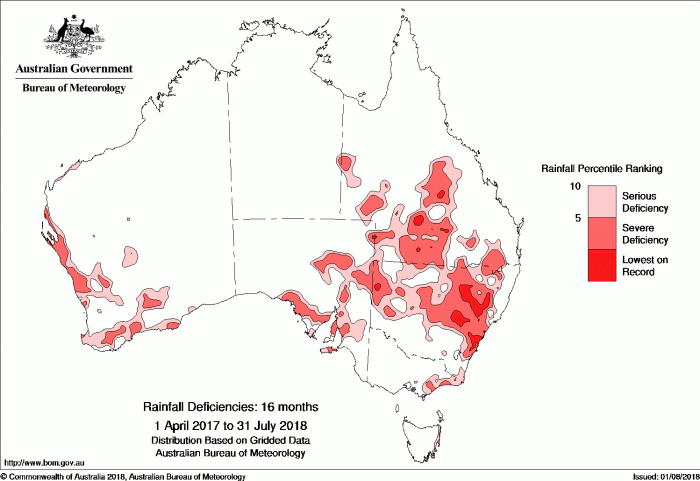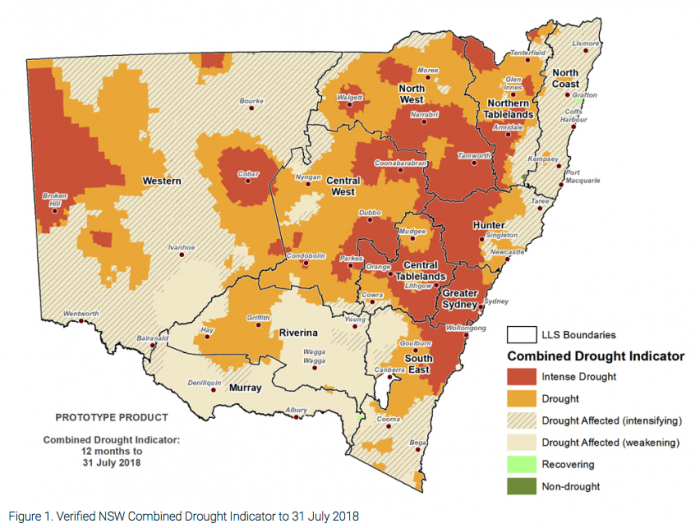Building future drought resilience
- By: "Farm Tender" News
- Rural Property News
- Aug 19, 2018
- 820 views
- Share

100% of NSW has been declared as drought affected with a large portion in severe drought. A large part of Queensland is also affected with some regions running on a 7-year drought streak. In fact, history tells us that the current drought in NSW and western QLD is one of the worst on record. Climatic predictions report that droughts are expected to become more prevalent in the future.
2018 drought
Not only has rainfall been lower than average (or non-existent) impacting on-farm grazing resources, the impacts on-farm are magnified by the fact that:
* roughage sources (fodder for stock feed) have depleted and become extremely expensive to buy and cart. The drought is widespread and significant, reducing the supply,
* groundwater sources have started to deplete, meaning traditionally ‘reliable’ sources are drying up, and
* experiencing drought in winter months is again compounded by the fact that livestock requires 30% more nutrition than they do in warmer months.
There is no denying a drought can be crippling, devastating and demoralising. It hits corporate enterprises, farmers and families in the most negative of ways.

In a social sense, we want to help. The ABC has pulled together a great list of “do’s and don’ts” when it comes to providing support. The important thing for all those impacted to know is that they are not alone. They do have the support of a nation. And that living through year after year of dry doesn’t make them a bad person, or necessarily a bad farmer.

Drought declared NSW August 2018
So what else can be done? Can we manage this risk better? Does it mean that ‘Ag’ is a bad investment?
As a business who believes passionately in the value of agricultural investment, we do have an optimistic approach to this. Drought is inevitable. It is part of the cycle of running an agricultural enterprise. As are other factors like a flood, fire, global economic conditions, commodity prices, etc… All of these are known risk factors, and modern enterprises need to prepare themselves as best they can for the potential impacts, in an effort to minimise the cost of ‘crisis’. Through the use of on-farm real-time data, it is possible to make decisions earlier. By keeping a balanced strategic approach, by managing a grazing enterprise as an environmental system, it is possible to lessen losses.
As an investment, ag can be fantastic. The prime factor in evaluating it as an asset class is the timeframe. It is an excellent investment over a long-time horizon. Just like financial markets can vary and vary wildly at any point in time, so too can ag investment returns. Over the long-term horizon, however, they perform well.
So back to this drought. What should we do about it?
From a human perspective, we need to be compassionate and do what we can to get those who are hit hardest through it. As an industry, we also need to look at ourselves and how we operate. Can we take advantage of new technology? Can we do more to ‘make hay while the sun shines (or rains fall)? Should we reduce stocking numbers on average at all times to allow for soil protection and development? Should we invest in additional infrastructure that helps manage grazing and access to water? What practices are leaving us exposed to risk unnecessarily?
How can we build resilience in our balance sheet, environment and people moving forward to assure our industry prospers?
Building resilience
For our clients, this is how we have been working and continue to work to minimise the impact of drought:
* We seek to own assets in the temperate zones of Australia where droughts have historically been shorter in time length and severity
* These assets have been developed to have more reliable water sources
* These assets are managed in a way that builds resilience into the ecosystem to store moisture and preserve ground cover
* Our management style ensures we act early when conditions look to be changing through the use of data, technology and on the ground observation
* We propose a structured decision-making process and act swiftly
* We educate our management teams to enable critical thinking and problem solving
The longer term impacts
Even when 100% of the management decisions are made ‘right’ in the time leading up to a drought, there are long-term impacts that need to be considered:
* Businesses will have a couple of leaner years as they rebuild livestock herds and revenue
* Once the season breaks there will be a bounce to livestock markets as producers re-enter the market
* Farm inventories generally are ok for cash, light on for livestock whilst building grass dry matter.
Now is the time to shine the light on ideas that help graziers prepare for drought so that the impacts are minimised as best as is possible. We are very passionate about our thriving industry in Australia and are keen to see investors and owner/operators benefit from the risk and challenge involved in grazing and cropping enterprises.
Australia, despite being one of the drier climates in the world, is well placed to play a significant role in global food and fibre production well into the future. It makes sense to invest here. So, let’s do what we can to support our farmers, now, and into the future.










Share Ag News Via